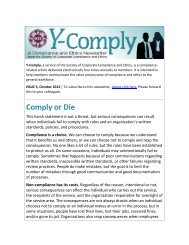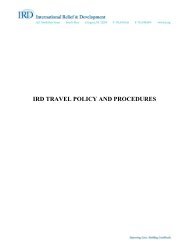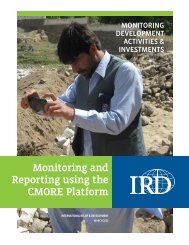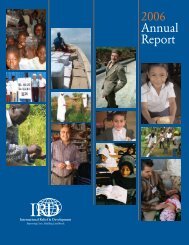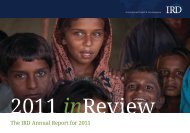Roof-Top Rainwater Harvesting Best Practices Guide - International ...
Roof-Top Rainwater Harvesting Best Practices Guide - International ...
Roof-Top Rainwater Harvesting Best Practices Guide - International ...
You also want an ePaper? Increase the reach of your titles
YUMPU automatically turns print PDFs into web optimized ePapers that Google loves.
<strong>Roof</strong>-<strong>Top</strong> <strong>Rainwater</strong><br />
<strong>Harvesting</strong> <strong>Best</strong><br />
<strong>Practices</strong> <strong>Guide</strong>
ACKNOWLEDGEMENTS<br />
<strong>International</strong> Relief and Development (IRD) would<br />
like to thank USAID’s Office of US Foreign Disaster<br />
Assistance (OFDA) for their on-going partnership<br />
and shared commitment to improving the health<br />
and livelihoods of vulnerable communities in<br />
Zimbabwe and across the globe. Many thanks also<br />
go to everyone on the IRD team who contributed<br />
to the creation of this best practices guide. Lastly,<br />
a special thank you is extended to participants<br />
of the Regional <strong>Roof</strong>top <strong>Rainwater</strong> <strong>Harvesting</strong><br />
Workshop for Southern Africa held in Harare<br />
from 5-6 December 2012 whose contributions<br />
and feedback enabled us to develop this best<br />
practices guide.
<strong>Roof</strong>-<strong>Top</strong> <strong>Rainwater</strong> <strong>Harvesting</strong><br />
<strong>Best</strong> <strong>Practices</strong> <strong>Guide</strong><br />
1. INTRODUCTION ................................................. 1<br />
1.1. <strong>Best</strong> <strong>Practices</strong> <strong>Guide</strong> ........................................ 2<br />
2. BACKGROUND................................................... 4<br />
2.1. Overview .................................................. 4<br />
2.2. <strong>Rainwater</strong> <strong>Harvesting</strong> Technologies ......................... 4<br />
3. HARDWARE: DESIGN OPTIONS AND MATERIALS .................. 5<br />
3.1. Design Considerations...................................... 5<br />
3.2. Infrastructure .............................................. 5<br />
3.3. Design Tools ............................................... 5<br />
3.4. Design <strong>Best</strong> <strong>Practices</strong> ....................................... 7<br />
3.5. Cost of Technology: ....................................... 11<br />
4. SOFTWARE: COMMUNITY OWNERSHIP .........................13<br />
4.1. Beneficiary Selection ......................................13<br />
4.2. User Contributions ........................................15<br />
4.3. Collaboration with Government, Local Authorities<br />
and Partners ..............................................15<br />
4.4. Gender Considerations ....................................16<br />
4.5. System Management and Training .........................18<br />
4.6. Monitoring and Evaluating ................................19<br />
5. REPLICABILITY FACTORS ........................................21<br />
6. REFERENCES....................................................22
Tables<br />
Table 1: <strong>Roof</strong>-top <strong>Rainwater</strong> <strong>Harvesting</strong> Water Storage Methods ............... 3<br />
Table 2: Materials options for <strong>Roof</strong>-top RWH gutters . . . . . . . . . . . . . . . . . . . . . . . . . . 10<br />
Table 3: Cost Per Beneficiary Comparison of Root-top <strong>Rainwater</strong><br />
System Designs Constructed by IRD in Zimbabwe .................. 11<br />
Figures<br />
Figure 1. Simulation and Assumptions for the Selected 10,000lt<br />
Capacity Tank for Households ...................................... 6<br />
Figure 2. Simulation and Assumptions for the Selected 30,000lt<br />
Capacity Tank for Schools........................................... 6<br />
Figure 3: IRD Zimbabwe ....................................................16<br />
Figure 4: Establishing Responsibility Structures for Water<br />
Management at Different Levels ...................................17<br />
Figure 5: WASH Manual & Toolkit............................................18<br />
Figure 6: Examples of Monitoring Indicators.................................19<br />
Figure 7: Willingness-to-Pay Study ..........................................21
1 Introduction<br />
As the global population advances past the 7<br />
billion mark in 2011, the earth’s already limited<br />
resources are being placed under increasing<br />
demand. Water is a resource of critical importance,<br />
and although significant strides have been made<br />
towards improving access to water, challenges<br />
brought about by climate change continue to<br />
compound water scarcity challenges. According<br />
to UNICEF and WHO, over 780 million people<br />
remain in need of improved sources of drinking<br />
water, with 2.5 billion still lacking improved<br />
sanitation. 1 A variety of environmentally friendly<br />
and sustainable techniques have been developed<br />
in response to challenges associated with the<br />
provision of clean water supplies. Rain water<br />
harvesting (RWH) is one such alternative water<br />
supply source.<br />
<strong>Rainwater</strong> harvesting involves the collection and<br />
storage of rainwater, which is used for domestic,<br />
agricultural, industrial and environmental<br />
purposes. 2 It has globally been practiced in<br />
various forms for centuries, as an alternative to<br />
unsafe or limited underground water resources.<br />
Today, RWH is increasingly recognised as a<br />
relatively low-cost intervention which can be<br />
employed to improve access to clean water,<br />
and which has the potential to better people’s<br />
livelihoods. RWH not only addresses MDG Goal 7<br />
which underlines improving sustainable access<br />
to safe drinking water and sanitation; it can also<br />
play a role in achieving poverty reduction, hunger,<br />
disease, environmental and gender issues, all<br />
of which “depend on the availability of water in<br />
acceptable quality and adequate quantities to<br />
meet their targets.” 3<br />
RWH has gained acceptance at local, national,<br />
and international levels because of this<br />
potential. Forums such as the <strong>Rainwater</strong><br />
Partnership, which was formed in The Hague<br />
in 2004, are working to promote the use of<br />
RWH technologies and its integration in<br />
water policies across the globe. Stakeholders<br />
at all levels, including major bilateral donors<br />
such as USAID, DIFD, EU and AUSAID, as well<br />
as governments in both the global North<br />
and South are increasingly supporting<br />
RWH programs as part of creating long-term<br />
solutions to water supply and health-related<br />
issues.<br />
<strong>Roof</strong>-<strong>Top</strong> <strong>Rainwater</strong> <strong>Harvesting</strong> <strong>Best</strong> <strong>Practices</strong> <strong>Guide</strong> 1
Today, RWH is increasingly recognised as a relatively low-cost<br />
intervention which can be employed to improve access to clean water,<br />
and which has the potential to better people’s livelihoods.<br />
1.1. <strong>Best</strong> <strong>Practices</strong> <strong>Guide</strong><br />
The main objective of this guide is to provide<br />
organisations implementing roof-top RWH<br />
programming with a reference tool for roof-top<br />
RWH best practices. When such best practices are<br />
followed, roof-top RWH not only adds new sources<br />
of water, but it can also improve communities’<br />
water management capacity and resilience to<br />
disasters.<br />
IRD Zimbabwe has developed the <strong>Roof</strong>-<strong>Top</strong><br />
<strong>Rainwater</strong> <strong>Harvesting</strong> <strong>Best</strong> <strong>Practices</strong> <strong>Guide</strong><br />
based on practical field experience during the<br />
implementation of three USAID/OFDA-funded<br />
programs in Zimbabwe: the Peri-Urban <strong>Roof</strong>top<br />
<strong>Rainwater</strong> <strong>Harvesting</strong> (PROOF I & II) programs<br />
from 2009 and 2011, and the Zimbabwe <strong>Roof</strong>top<br />
<strong>Rainwater</strong> <strong>Harvesting</strong> (ZimROOF) program from<br />
2012 to 2013. The guide is also informed by<br />
various contributors’ knowledge shared through<br />
the Regional <strong>Roof</strong>-<strong>Top</strong> <strong>Rainwater</strong> <strong>Harvesting</strong><br />
Workshop for Southern Africa, organised by<br />
IRD in December 2012. The workshop allowed<br />
for partners from across the region to highlight<br />
various applications of roof-top RWH technologies<br />
and some of the challenges and successes<br />
associated with it.<br />
In the first section of the guide, various rooftop<br />
RWH technologies are introduced, giving<br />
examples from Southern Africa. The following<br />
sections put forward best practices for roof-top<br />
RWH. Firstly, roof-top RWH system hardware is<br />
discussed, which refers to the physical aspects of<br />
the entire roof-top rainwater harvesting system,<br />
including system design, sizing and material<br />
selection.<br />
The next section highlights ‘software’ issues;<br />
referring to behaviour changes and social<br />
considerations which ensure the sustainability<br />
of the intervention. Such activities include<br />
system ownership and participation, trainings<br />
in system management, and collaboration with<br />
project stakeholders. <br />
1 UNICEF and WHO. 2012. Progress on Drinking Water and Sanitation: 2012 Update, p.2.<br />
2 UNEP and GWP.. <strong>Rainwater</strong> and the Millennium Development Goals. Available from: www.unep.org/<br />
pdf/RWH/intro.pdf . p7.<br />
3 Ibid p.4.<br />
2 <strong>Roof</strong>-<strong>Top</strong> <strong>Rainwater</strong> <strong>Harvesting</strong> <strong>Best</strong> <strong>Practices</strong> <strong>Guide</strong>
2 Background<br />
2.1. Overview<br />
<strong>Roof</strong>-top RWH consists of a range of<br />
technologies which are used to collect<br />
and store water. Depending on the chosen<br />
technology, the harvested water can be used<br />
for various purposes, including drinking,<br />
household use and agricultural uses.<br />
<strong>Roof</strong>-top RWH presents an alternative water<br />
source and should be considered in the<br />
following contexts:<br />
ɇɇ<br />
Where there is poor underground water quality<br />
(possibly due to mining activities or saline<br />
water)<br />
ɇɇ<br />
Where hand pumps are insufficient due to<br />
the size of population serviced; or where<br />
there are low water tables.<br />
ɇɇ<br />
As a low cost alternative to expensive<br />
municipal services in high-density<br />
population areas.<br />
ɇɇ<br />
In areas increasingly affected by<br />
climate change, for instance, semi-arid zones or<br />
where there is a high degree of fluctuations in<br />
aquifer levels.<br />
ɇɇ<br />
In rural/urban institutions such as schools<br />
and health clinics where access to a reliable<br />
water source is a challenge.<br />
2.2. <strong>Rainwater</strong> <strong>Harvesting</strong><br />
Technologies<br />
The choice of technology is context-specific, as<br />
it depends on needs of the community and the<br />
feasibility of the technology.<br />
Existing technologies vary depending on:<br />
i. The intended use of the water:<br />
drinking water, household use,<br />
agricultural purposes<br />
ii. Method of collection: fog, roof-top, ground,<br />
sub-surface<br />
iii. Storage method: these can be divided<br />
between above ground or sub-surface as<br />
outlined in Table 1.<br />
There are advantages and disadvantages<br />
associated with each roof-top RWH technology.<br />
Technology selection should be based on needs<br />
assessments and feasibility studies, which take<br />
a number of factors into account. Such factors<br />
include geographical characteristics of the<br />
area, associated costs of the technology, and<br />
the ability of the technology to meet the needs<br />
of the community. Section 3.4.1. on page 7<br />
shows examples of roof-top RWH technology<br />
applications from southern Africa. <br />
Table 1: <strong>Roof</strong>-<strong>Top</strong> <strong>Rainwater</strong> <strong>Harvesting</strong> Water Storage Methods<br />
ABOVE-GROUND STORAGE<br />
SUB-SURFACE STORAGE<br />
ɇɇPlastic (PVC) tanks<br />
ɇɇFerro-cement tanks<br />
ɇɇMasonry tanks (blocks, brick or<br />
stone)<br />
ɇɇGalvanized steel tanks (with<br />
geomembrane lining)<br />
ɇɇReinforced concrete tanks<br />
ɇɇReinforced concrete tanks<br />
ɇɇTanks/Cisterns (with<br />
geomembrane lining)<br />
ɇ ɇ Aquifer (groundwater recharge or<br />
raising groundwater level)<br />
<strong>Roof</strong>-<strong>Top</strong> <strong>Rainwater</strong> <strong>Harvesting</strong> <strong>Best</strong> <strong>Practices</strong> <strong>Guide</strong> 3
Typical <strong>Roof</strong>-top RWH system at a school in Zimbabwe<br />
3 Hardware: Design Options and Materials<br />
A roof-top RWH system basically consists of<br />
a) the roof-top that provides the catchment<br />
area, b) gutters that collect the water and<br />
c) a storage tank, where the collected water is<br />
stored. The design of each of the components<br />
depends on the available roof-top area, the<br />
precipitation in the area where the building<br />
is located and the users’ water consumption<br />
requirements.<br />
3.1. Design Considerations<br />
The decision of which roof-top RWH technology<br />
to implement depends on a number of factors.<br />
Consider the following:<br />
ɇɇ<br />
Potential volume requirements<br />
ɇɇ<br />
Quality requirements<br />
ɇɇ<br />
Availability of funds<br />
ɇɇ<br />
Materials and skills available locally<br />
ɇɇ<br />
Space availability<br />
ɇɇ<br />
Rainfall patterns<br />
3.2. Infrastructure<br />
Consider the following questions which relate to<br />
the suitability of roof-top<br />
RWH systems to the community and the<br />
existing infrastructure:<br />
ɇɇ<br />
Does the house or institution have sound walls/<br />
rooflines to add gutter support?<br />
ɇɇ<br />
Do suitable roof catchment surfaces exist in the<br />
community?<br />
ɇɇ<br />
Does the household/institution have sufficient<br />
space for a tank?<br />
ɇɇ<br />
Is the site susceptible to animal contamination?<br />
ɇɇ<br />
How many people live in the house or use the<br />
institution, and would it be effective or efficient<br />
to have a roof-top RWH system installed in that<br />
context?<br />
ɇɇ<br />
Where is the closest water source and are<br />
there any water quality issues to take into<br />
consideration?<br />
3.3. Design Tools<br />
Correct sizing of the storage tank is critical in<br />
order to ensure that households or institutions<br />
have enough drinking water stored to carry<br />
them through the dry season. An incorrect sizing<br />
decision can be costly - too large a tank will never<br />
fill or empty, and too small a tank will fill quickly<br />
but also empty quickly. Correct sizing requires<br />
careful consideration of anticipated consumption<br />
needs during particular periods.<br />
<strong>Roof</strong>-<strong>Top</strong> <strong>Rainwater</strong> <strong>Harvesting</strong> <strong>Best</strong> <strong>Practices</strong> <strong>Guide</strong> 5
There are parameters and approaches to be<br />
considered in the determination of the size of<br />
the tank. These include:<br />
ɇɇ<br />
Demand-side approach: this is a basic<br />
calculation using consumption rates and<br />
number of users to estimate the largest storage<br />
size required. It is important to factor in<br />
consumption rates during both the rainy and<br />
the dry season.<br />
It is possible to use a basic water requirement<br />
(BWR) which is established by governments.<br />
In Africa, many countries have adopted 20-35<br />
litres/capita/day as BWR. 1 An alternative basis is<br />
presented by SPHERE standards which set the<br />
average water use for drinking, cooking and<br />
personal hygiene in any household at least at 15<br />
litres per person per day. 2<br />
ɇɇ<br />
Supply-side approach: a calculation using<br />
roof area, annual rainfall, run-off coefficient,<br />
and percentage losses to calculate the likely<br />
supply that the tank will need to be able to<br />
accommodate. This is particularly useful where<br />
there is uneven distribution of annual rainfall.<br />
ɇɇ<br />
Computer models: this is based on<br />
mathematical model of the actual system i.e.<br />
a simulation. Figure 1 and 2 present typical<br />
simulations for tank sizes adopted by IRD in its<br />
rainwater programmes across Southern Africa.<br />
Figure 1. Simulation and assumptions for the<br />
selected 10,000lt capacity tank for households<br />
Tank Simulation<br />
IRD developed a tool to run tank simulations,<br />
using daily precipitation data over long periods of<br />
time and based on assumptions of consumption<br />
per person during dry/rainy seasons. The<br />
simulation considers the following factors/<br />
assumptions:<br />
ɇɇ<br />
Percentage losses (typically around 10%)<br />
ɇɇ<br />
Catchment area (roof area)<br />
ɇɇ<br />
Number of people using the system<br />
ɇɇ<br />
Liters per person per day (in both rainy and dry<br />
seasons)<br />
ɇɇ<br />
Daily average precipitation<br />
ɇɇ<br />
Tank size<br />
By changing the assumptions, you can see<br />
how the water availability would change<br />
throughout the year, which can help you<br />
determine the most advantageous size of tank<br />
to construct. At certain relatively high usage<br />
levels, the water tank will often be empty.<br />
Still, during the rainy season it could<br />
provide clean water and reduce incidence of<br />
waterborne disease.<br />
Key points in tank simulation:<br />
Point 1: Begin by calculating number and size<br />
of tanks. The simulation has to be done for<br />
each tank, and not, for example, from the total<br />
collection area.<br />
Point 2: Consider the location (for efficiency, to<br />
serve the most roofs possible) and the topology.<br />
Point 3: Efforts must be made for 85 or more<br />
percentage of days with water in the tank<br />
(satisfaction ratio). (Cost is a limiting factor.)<br />
Point 4: All information gathered should<br />
be verified and validated, for example,<br />
information on rainfall patterns and<br />
demographics.<br />
Figure 2. Simulation and assumptions for the<br />
selected 30,000lt capacity tank for schools<br />
6 <strong>Roof</strong>-<strong>Top</strong> <strong>Rainwater</strong> <strong>Harvesting</strong> <strong>Best</strong> <strong>Practices</strong> <strong>Guide</strong>
3.4. Design <strong>Best</strong> <strong>Practices</strong><br />
3.4.1. Water Storage Methods<br />
After having determined the tank size, decide<br />
what kind of material to use. The table below<br />
lists design options, and the advantages and<br />
disadvantages of each for the technologies listed<br />
in Table 1 on page 3. Section 3.5. highlights<br />
factors which influence the costs of roof-top RWH<br />
technologies. Costs vary widely depending on<br />
many context-specific factors.<br />
1. Above-ground: Plastic (PVC) Tanks<br />
Advantages<br />
ɇɇ<br />
Off-the shelf stable tanks<br />
ɇɇ<br />
Simple installation<br />
ɇɇ<br />
Flexibility/adaptability<br />
Plastic tanks in Swaziland<br />
Disadvantages<br />
ɇɇ<br />
Prone to tampering<br />
ɇɇ<br />
High transportation costs<br />
ɇɇ<br />
Tanks have predefined dimensions/volume<br />
ɇɇ<br />
Medium-high per capita cost.<br />
ɇɇ<br />
Should be covered in shade to avoid UV damage<br />
ɇɇ<br />
Requires anchors to reduce vulnerability to<br />
wind/theft<br />
ɇɇ<br />
More difficult to clean without dismantling<br />
the system<br />
2. Above-ground: Ferro-cement Tanks<br />
Advantages<br />
ɇɇ<br />
Durable if correctly constructed<br />
ɇɇ<br />
Relatively low cost<br />
ɇɇ<br />
Most materials available locally, low transport costs<br />
ɇɇ<br />
Design flexibility<br />
ɇɇ<br />
Fixed location (can’t be stolen or blown away)<br />
ɇɇ<br />
Less labor intensive than brick or concrete; but more<br />
so than plastic tanks<br />
ɇɇ<br />
Replicable locally, encouraging local participation and<br />
job creation<br />
ɇɇ<br />
Does not require a pumping mechanism to<br />
extract water<br />
ɇɇ<br />
Easy to clean and maintain<br />
Ferro-cement tank at household in Zimbabwe<br />
Disadvantages<br />
ɇɇ<br />
Requires specialized construction skills<br />
ɇɇ<br />
Requires a tank mould to be manufactured<br />
ɇɇ<br />
Fixed location means it cannot be relocated<br />
ɇɇ<br />
Cracks or imperfections to the concrete are difficult to<br />
rectify once the tank is complete<br />
ɇɇ<br />
Requires quality pit sand for cement mixture<br />
ɇɇ<br />
Limited tank size due to construction materials used<br />
<strong>Roof</strong>-<strong>Top</strong> <strong>Rainwater</strong> <strong>Harvesting</strong> <strong>Best</strong> <strong>Practices</strong> <strong>Guide</strong> 7
3.4.1. Water Storage Methods continued<br />
3. Above-ground: Masonry Tanks (blocks, bricks, or stone)<br />
Advantages<br />
ɇɇ<br />
Relatively low cost<br />
ɇɇ<br />
Most appropriate when materials are available locally<br />
ɇɇ<br />
Little construction training required<br />
ɇɇ<br />
Relatively more resistant to corrosion than<br />
galvanized steel<br />
ɇɇ<br />
Community involvement and job creation<br />
opportunities<br />
ɇɇ<br />
Fixed and not affected by weather<br />
ɇɇ<br />
Does not require a pumping mechanism to<br />
extract water<br />
Stone storage tank in Zimbabwe<br />
Disadvantages<br />
ɇɇ<br />
Relatively more variation in durability and quality<br />
without adequate planning, quality control, and<br />
supervision<br />
ɇɇ<br />
May require more construction time<br />
ɇɇ<br />
Blocks and bricks lack reinforcement and are limited<br />
in size and less durable<br />
ɇɇ<br />
If leaks occur it is difficult to fix without having to replaster<br />
the entire tank.<br />
ɇɇ<br />
Can be more prone to leaks if not constructed to<br />
standard<br />
4. Above -ground: Galvanized Steel Tank<br />
Advantages<br />
ɇɇ<br />
Can be relocated<br />
ɇɇ<br />
Flexibility in tank dimensions<br />
ɇɇ<br />
Can be mass produced<br />
ɇɇ<br />
Standardized<br />
ɇɇ<br />
Relatively long life (30–50 years) if installed correctly<br />
ɇɇ<br />
Can stimulate job creation and support local<br />
manufacturing industries in country<br />
ɇɇ<br />
Can be lined with geomembrane to prevent leaks<br />
ɇɇ<br />
Does not require a pumping mechanism to<br />
extract water<br />
ɇɇ<br />
Easy to clean/maintain<br />
Steel tank in Zimbabwe<br />
Disadvantages<br />
ɇɇ<br />
Can be more expensive than plastic or<br />
ferro-cement tanks<br />
ɇɇ<br />
Susceptible to corrosion if not installed correctly<br />
ɇɇ<br />
Heavy and difficult to transport<br />
ɇɇ<br />
Not always available in all countries due to lack of<br />
manufacturing capacity<br />
ɇɇ<br />
Subject to damage in transport<br />
8 <strong>Roof</strong>-<strong>Top</strong> <strong>Rainwater</strong> <strong>Harvesting</strong> <strong>Best</strong> <strong>Practices</strong> <strong>Guide</strong>
3.4.1. Water Storage Methods continued<br />
5. Above-ground: Reinforced concrete tank<br />
Advantages<br />
ɇɇ<br />
Durable<br />
ɇɇ<br />
Few size and shape limitations<br />
ɇɇ<br />
High community involvement<br />
ɇɇ<br />
Can be built using locally trained masons<br />
ɇɇ<br />
Materials usually found on local market; however might<br />
not be in close proximity to building site.<br />
ɇɇ<br />
Does not require a pumping mechanism to<br />
extract water<br />
Steel-reinforced concrete tank in Swaziland<br />
Disadvantages<br />
ɇɇ<br />
Relatively expensive<br />
ɇɇ<br />
Requires supervision and quality control<br />
during construction<br />
ɇɇ<br />
Labor intensive<br />
ɇɇ<br />
Requires water access during construction phase<br />
ɇɇ<br />
Materials may not be locally available (water, sand)<br />
ɇɇ<br />
Design requires a specialist<br />
ɇɇ<br />
Transport costs can be high<br />
6. Sub-surface: Reinforced Concrete Tank<br />
Advantages<br />
ɇɇ<br />
Durable when constructed well<br />
ɇɇ<br />
Does not occupy much above ground surface area<br />
ɇɇ<br />
Easy to maintain once constructed<br />
ɇɇ<br />
Can store large amounts of water<br />
ɇɇ<br />
Inlet piping can be connected below ground to<br />
avoid breakages<br />
Steel-reinforced concrete tank in Mozambique<br />
Disadvantages<br />
ɇɇ<br />
Expensive<br />
ɇɇ<br />
Requires skilled labor to construct<br />
ɇɇ<br />
Transport costs for materials can be high depending<br />
on location<br />
ɇɇ<br />
Requires a consistent supply of water during the<br />
construction phase<br />
ɇɇ<br />
Requires a pumping mechanism to extract water<br />
ɇɇ<br />
Difficult to repair if cracks/leaks appear<br />
7. Sub-surface: Tank/Cistern for Household <strong>Rainwater</strong> Storage<br />
Advantages<br />
ɇɇ<br />
Inexpensive<br />
ɇɇ<br />
Can provide supplementary water needs<br />
to households<br />
ɇɇ<br />
Does not require a lot of materials<br />
ɇɇ<br />
Does not require skilled labor to construct<br />
ɇɇ<br />
Ideal for rural households with limited water supply<br />
ɇɇ<br />
Does not occupy much space<br />
Household storage tank in Mozambique<br />
Disadvantages<br />
ɇɇ<br />
Limited size without reinforcement<br />
ɇɇ<br />
Cannot store large quantities of water<br />
ɇɇ<br />
Needs to be designed to prevent contamination<br />
<strong>Roof</strong>-<strong>Top</strong> <strong>Rainwater</strong> <strong>Harvesting</strong> <strong>Best</strong> <strong>Practices</strong> <strong>Guide</strong> 9
3.4.2. Catchment areas<br />
The majority of roof-top materials are suitable for<br />
rainwater catchment areas, including iron sheets<br />
and tiling. Non-corrosive materials such as metals<br />
are most suitable because they are less prone to<br />
build up and contamination from debris.<br />
3.4.3. Gutters<br />
Gutter design: consider optimal designs<br />
and sizes for the typical intensity of the<br />
precipitation, the slope of the roof, and<br />
how much of each rain event it is important<br />
to capture.<br />
Consider building gutters that capture the<br />
maximum capacity of rain, because later you<br />
may add tanks as demand increases.<br />
3.4.4. Connection between gutters and<br />
tanks<br />
Metal roof catchment area<br />
Note: It is widely perceived that water<br />
collected from asbestos catchment areas may<br />
be unfit to drink. As remedial action, ensure<br />
that no holes are drilled into asbestos sheets.<br />
Instead, fit gutters to the wall structure or<br />
fascia boards. It is also best to avoid materials<br />
with contaminants such as lead and asphalt.<br />
A range of sizes of PVC down piping is<br />
available, but it introduces a rigid system<br />
that is not adaptable to flushing and they<br />
need support because they are susceptible<br />
to wind. The former can be addressed by<br />
using an elbow that can unscrew the PVC<br />
pipe for flushing.<br />
It is important to use galvanized parts and<br />
accessories with galvanized gutters.<br />
Table 2: Materials Options for <strong>Roof</strong>-<strong>Top</strong> RWH Gutters<br />
Material Advantage Disadvantage<br />
Galvanized steel<br />
PVC<br />
Aluminium<br />
ɇɇ<br />
Durable<br />
ɇɇ<br />
Can be customized to shape and size<br />
ɇɇ<br />
Large area allows for maximum water<br />
collection off roof<br />
ɇɇ<br />
Does not rust<br />
ɇɇ<br />
Usually available on the local market<br />
ɇɇ<br />
Cheaper than galvanized steel<br />
ɇɇ<br />
May be suitable for small roof areas. 1<br />
ɇɇ<br />
Low maintenance<br />
ɇɇ<br />
Easy to install/light weight<br />
ɇɇ<br />
Cheaper than galvanized steel<br />
ɇɇ<br />
Can be found in local markets<br />
ɇɇ<br />
Relatively easy to install as material is<br />
not heavy<br />
ɇɇ<br />
More expensive than other gutter options<br />
ɇɇ<br />
Might not be available locally and<br />
could require additional costs to have<br />
manufactured<br />
ɇɇ<br />
More difficult to install due to the<br />
weight of the gutters, requires structural<br />
reinforcement<br />
ɇɇ<br />
Prone to cracks and warps (sun exposure<br />
weakened them)<br />
ɇɇ<br />
Is less customizable.<br />
ɇɇ<br />
Gutters made from extruded plastic are<br />
durable but expensive. 2<br />
ɇɇ<br />
Typically smaller in size, so greater potential<br />
for losses off the roof<br />
ɇɇ<br />
Prone to rusting and theft<br />
ɇɇ<br />
Can more easily lose their original shape<br />
when exposed to the elements over time<br />
ɇɇ<br />
Easy to puncture during transport/<br />
installation<br />
10 <strong>Roof</strong>-<strong>Top</strong> <strong>Rainwater</strong> <strong>Harvesting</strong> <strong>Best</strong> <strong>Practices</strong> <strong>Guide</strong>
Table 3: Cost Per Beneficiary Comparison of <strong>Roof</strong>-<strong>Top</strong> <strong>Rainwater</strong> System Designs<br />
Constructed by IRD in Zimbabwe<br />
Tank Design<br />
Location<br />
Cost Per<br />
Beneficiary<br />
Notes<br />
Galvanized Steel Household (peri-urban) $90 18 users per household<br />
Galvanized Steel School (peri-urban) $44 200 students per tank<br />
Ferro-cement Household (rural) $78 16 users per household<br />
Ferro-cement School (rural) $29 150 students per tank<br />
3.4.5. Design Features for System<br />
Enhancement<br />
i. Trap/Filter: There should be a basket or<br />
filter before the tank or at the outlet to<br />
filter any debris.<br />
ii. Angled outlet pipe: such a design serves<br />
as an additional filter to ensure that any<br />
debris accumulating at the bottom of<br />
the tank will be avoided when water is<br />
collected from the outlet pipe.<br />
iii. Detachable gutters: this enables selfcleaning<br />
of the gutter system. Beneficiaries<br />
are trained to detach before the first rain of<br />
the season which will flush out any debris,<br />
and to reattach to start collecting water.<br />
iv. Tank door: by giving access to the tank,<br />
this enables sufficient cleaning of the<br />
inside of the tank according to<br />
maintenance schedule,<br />
v. Drainage outlet: for above-the-ground<br />
tanks, this feature enables removal of<br />
any accumulated debris during system<br />
maintenance.<br />
3.5. Cost of Technology<br />
The costs of roof-top RWH technologies vary<br />
considerably. Factors which influence the<br />
cost include:<br />
ɇɇ<br />
System design: capacity, layout and<br />
topography,<br />
ɇɇ<br />
Choice of materials,<br />
ɇɇ<br />
Construction/labour costs,<br />
ɇɇ<br />
Transportation;<br />
For cost comparisons between technologies,<br />
it is important to develop a measurement for<br />
comparison. Cost per cubic meter can serve<br />
as a useful means of comparing the<br />
technology costs.<br />
Depending on the type of project, developing<br />
a cost per person over a certain period may<br />
be more useful. This can vary considerably<br />
depending on the level of service, for example,<br />
institution, household, or school. Consideration<br />
of the number of people served and the demand,<br />
the ability of the technology to meet water supply<br />
needs, and the time period over which it can do<br />
so can enable a more informed decision by both<br />
project teams and the community.<br />
Based on the factors mentioned above, Table<br />
3 highlights examples of cost-per beneficiary<br />
calculations of various tank designs from IRD’s<br />
roof-top RWH programs in Zimbabwe to date.<br />
From the perspective of project management,<br />
the cost of the initial investment, operational<br />
costs, and costs of maintenance after the<br />
project handover should also be considered.<br />
1 African Development Bank. 2008. <strong>Rainwater</strong> <strong>Harvesting</strong> Handbook: Assessment of <strong>Best</strong> Practises and Experience in<br />
Water <strong>Harvesting</strong>, p13<br />
2 The Sphere Project, ‘Water Supply Standard 1: Access and Water Quantity’, Accessed May 10, 2013 at<br />
www.spherehandbook.org/en/water-supply-standard-1-access-and-water-quantity/<br />
<strong>Roof</strong>-<strong>Top</strong> <strong>Rainwater</strong> <strong>Harvesting</strong> <strong>Best</strong> <strong>Practices</strong> <strong>Guide</strong> 11
4 Software: Community Ownership<br />
The incorporation of socio-economic<br />
considerations is essential to ensuring the<br />
sustainability of roof-top RWH systems as<br />
a medium-term solution to water supply<br />
challenges. The socio-economic factors discussed<br />
below are linked to community ownership and<br />
are a prerequisite to the achievement of both<br />
short-term water supply targets, and in building<br />
community resilience to long-term health-related<br />
challenges.<br />
Participation engenders community<br />
ownership, which is a priority in all<br />
development interventions, and must occur at<br />
every stage of the project. In particular, local<br />
stakeholders offer an in-depth knowledge of<br />
the community’s political, economic, social<br />
and technological status which contributes to<br />
a program’s design and viability.<br />
4.1. Beneficiary Selection<br />
4.1.1. Needs Assessment<br />
The following assessments should be made when<br />
planning a roof-top RWH program:<br />
ɇɇ<br />
Does the community articulate improved access<br />
to clean water as not only a need, but as a<br />
priority? Choose an area based on need, not to<br />
compete with available alternatives.<br />
ɇɇ<br />
What are the needs of the most vulnerable<br />
members of the communities? include the<br />
poorer sections of society, women, the elderly,<br />
disabled, chronically ill, and child-headed<br />
households.<br />
ɇɇ<br />
Assess their access to alternative sources of<br />
water, their specific needs regarding roof-top<br />
RWH systems, and their ability to operate and<br />
maintain the systems.<br />
ɇɇ<br />
Establish the basic water requirements (BWR)<br />
per person. This can be established specific<br />
to the target area, or a national average can<br />
be used (In many African countries a BWR of<br />
20-35 liters/capita/day has been adopted). 1<br />
<strong>Roof</strong>-<strong>Top</strong> <strong>Rainwater</strong> <strong>Harvesting</strong> <strong>Best</strong> <strong>Practices</strong> <strong>Guide</strong> 13
Household Level Sub-surface <strong>Rainwater</strong><br />
Storage Tank<br />
Household Above ground Galvanized Steel<br />
Storage Tank<br />
Household storage tank in Mozambique<br />
Household storage tank in Zimbabwe<br />
Following best practices for beneficiary selection results in the adoption of the most appropriate oof-top RWH<br />
technology for the targets. In the rural context of Inhambane in Mozambique, beneficiaries opted for a local<br />
innovation, the ‘Pote’ (above left), which the program adapted for improved water supply results. This is a low<br />
cost, easy construction storage option which uses locally available inputs.<br />
In urban and peri-urban areas near Harare, Zimbabwe, feasibility studies, willingness to pay studies<br />
and cost effective initial investments into the technology informed the choice of galvanised steel tanks<br />
(above right).<br />
SPHERE standards set the average water use for<br />
drinking, cooking and personal hygiene in any<br />
household is at least 15 litres per person per day<br />
in emergency settings. 2<br />
ɇɇ<br />
Assess potential drawbacks. Working with the<br />
community, assess any potential drawbacks<br />
or conflicts that may arise in relation to rooftop<br />
RWH systems. It is also useful to draw on<br />
lessons learnt from previous experiences in<br />
the community. These experiences can be<br />
projects by the community itself or projects<br />
implemented by any other stakeholders. 3<br />
4.1.2. Technology Selection<br />
To confirm a choice of roof-top RWH technology,<br />
project proponents should consider the following<br />
questions:<br />
ɇɇ<br />
What are the existing water supply alternatives?<br />
Any historical data on water availability and<br />
quality and on the feasibility of other water<br />
supply options such as hand pumps will be<br />
useful.<br />
ɇɇ<br />
Why do they need supplementation? Is there<br />
an established demand for the alternative<br />
technology and what are the commitments for<br />
operation and maintenance?<br />
ɇɇ<br />
What are the social, economic and<br />
environmental implications of alternative water<br />
supply options? For example, considering the<br />
ability of the community to invest in roof-top<br />
RWH systems, hand pump, or any public supply<br />
options; and whether this project or alternative<br />
water supply options which the community is<br />
choosing from threaten the livelihood of any<br />
community members, such as water vendors, or<br />
centrally supplied water systems in urban areas,<br />
for example. 4<br />
ɇɇ<br />
Project proponents must share roof-top RWH<br />
technology options with the entire community.<br />
Such an exercise ensures that the project is a<br />
demand-led initiative. The community should<br />
be engaged in order to identify the technology<br />
that is most feasible and sustainable to their<br />
context.<br />
ɇɇ<br />
Each technology option should be presented<br />
on equal terms, exploring the merits and<br />
disadvantages of each. 5 This can be a costbenefit<br />
analysis of the different technology and<br />
material options.<br />
ɇɇ<br />
Project proponents must advocate for their<br />
chosen technology option. Having been<br />
presented alongside alternative technologies,<br />
social marketing including information<br />
14 <strong>Roof</strong>-<strong>Top</strong> <strong>Rainwater</strong> <strong>Harvesting</strong> <strong>Best</strong> <strong>Practices</strong> <strong>Guide</strong>
dissemination can sensitize the community<br />
on the potential benefits of the project’s<br />
technology.<br />
ɇɇ<br />
As part of advocacy, present a cost-benefit<br />
analysis with linkages to local institutions.<br />
This will, for example, make clear the cost of<br />
treating sicknesses due to drinking water from<br />
an unprotected water source, as opposed to<br />
the benefits of investing in clean water supply<br />
technologies.<br />
Establishing these factors in selecting a<br />
technology enables project managers to create<br />
realistic budgets, strategies for cost recovery and/<br />
or levels of subsidies. 6<br />
4.2. User Contributions<br />
Involving the communities at all stages, including<br />
financial and labour contributions is an important<br />
practice to be incorporated into project plans.<br />
Beneficiary contributions can be in the form of<br />
funds, labor, and materials, and they should be<br />
maximized, sustained, and quantified during<br />
the planning and design stages. This is an<br />
exercise to be carried out at all relevant levels:<br />
household, institutional, or wider community.<br />
Funds: A community may contribute only a<br />
fraction of the cost by way of funds, but much<br />
more in-kind, for example, by giving sand,<br />
water or bricks.<br />
Labor: Some roof-top RWH techniques involve<br />
substantial amount of unskilled labor such as<br />
earth moving and fetching of local materials. The<br />
willingness of a community to contribute labor<br />
in such a case is a substantial contribution which<br />
affects the cost of the project. It also has a positive<br />
impact on building community ownership of rooftop<br />
RWH systems.<br />
Benefits of assessing the affordability of roof-top<br />
RWH systems for the target beneficiaries, and<br />
their willingness to pay for them:<br />
ɇɇ<br />
Ability to create correct cost calculations<br />
ɇɇ<br />
The assessment will demonstrate the market<br />
opportunity for local business, and allow<br />
project to develop any private sector financing<br />
options. There is need for financial mechanisms<br />
to support the demand and income levels<br />
of interested households. The project can<br />
proceed to build local private sector capacity in<br />
roof-top RWH system manufacturing- making<br />
the systems available on the local market, at<br />
affordable prices to the local community.<br />
ɇɇ<br />
Ability to plan for building willingness of<br />
communities to cost share through, for<br />
example, advocacy and social marketing.<br />
ɇɇ<br />
Enhances a sense of (and practical) project<br />
ownership by the beneficiaries.<br />
4.3. Collaboration with<br />
Government, Local<br />
Authorities and Partners<br />
Project success will be greatly enhanced by<br />
collaborating with all relevant stakeholders<br />
in the target areas. Projects are often<br />
implemented in areas where there are preexisting<br />
or on-going projects by government,<br />
other organisations, or the community itself.<br />
Emphasis should be placed on building upon<br />
existing plans or strategies of the Government<br />
and partners to use resources more efficiently<br />
and maximize the collective impact.<br />
4.3.1. Compliance<br />
Governments will have national strategies<br />
for improving water supply and sanitation.<br />
Projects should work within these, to gain<br />
support of their project and more simply<br />
because they share the same overall goal.<br />
Key guidelines are:<br />
ɇɇ<br />
Particularly in rural areas, seek permission and<br />
involvement of authorities from the highest<br />
level down, including NGOs and all other local<br />
stakeholders, and agree on standards from the<br />
earliest stages.<br />
ɇɇ<br />
Get permission to make use of available toolkits<br />
and curriculums. Establishing a working<br />
partnership means parties will collaborate to<br />
adapt them and to incorporate missing content<br />
where it is identified.<br />
ɇ ɇ As appropriate, ensure that relevant<br />
stakeholders are informed and invited to<br />
<strong>Roof</strong>-<strong>Top</strong> <strong>Rainwater</strong> <strong>Harvesting</strong> <strong>Best</strong> <strong>Practices</strong> <strong>Guide</strong> 15
Figure 3: IRD Zimbabwe<br />
Due to perceptions of higher pollution levels in urban areas, national policy in Zimbabwe recognises roof-top<br />
RWH as an improved water source for rural communities, and not urban communities. IRD, in partnership with the<br />
Government has completed two urban roof-top RWH programs and shared the results of water quality testing with<br />
Government and water forums to dispel concerns over water<br />
quality.<br />
Pilot projects that have been approved by the government<br />
are essential to inform policy development and in getting<br />
government support for expanding their list of approved<br />
technologies in urban and rural contexts.<br />
In collaboration with its partners, IRD continues to advocate<br />
for the safety of roof-top RWH technology by sharing research,<br />
experience and results with government authorities and water<br />
sector stakeholders.<br />
participate in any trainings or demonstrations<br />
related to the construction, usage and<br />
maintenance of the roof-top RWH systems.<br />
4.3.2. Collaboration<br />
To create better institutional acceptance of rooftop<br />
RWH, collaborate with institutions already<br />
working with roof-top RWH.<br />
ɇɇ<br />
Discuss your idea and select sites together, and<br />
continue that throughout the project lifecycle<br />
up until handover.<br />
ɇɇ<br />
Although institutions typically share a common<br />
end-goal, priorities between stakeholders<br />
may differ. It is important to understand their<br />
position vis a vis the project goals. Continually<br />
seek areas of commonality and opportunities to<br />
engage and involve authorities.<br />
ɇɇ<br />
Document, learn from, and take<br />
responsibility for setbacks and challenges.<br />
This is important in building an on-going<br />
culture of partnership.<br />
4.3.3. Advocacy<br />
Stakeholders at various levels are increasingly<br />
recognising the wide contribution that roof-top<br />
RWH can make towards meeting developmental<br />
goals. This is because MDGs, including those<br />
aimed at reducing hunger and poverty and on<br />
ensuring environmental sustainability partly<br />
depend on the availability of water in acceptable<br />
quality and quantities. 7<br />
Projects should advocate to authorities<br />
on the potential benefits of roof-top RWH<br />
to developmental goals, and encourage<br />
development or improvements on<br />
relevant policies that are in line with<br />
enhancing progress.<br />
In order to influence national policy where<br />
necessary, and to gain government support for<br />
the project, it is important to:<br />
ɇɇ<br />
Map and share experiences and results of rooftop<br />
RWH implementation,<br />
ɇɇ<br />
Coordinate with partners and jointly<br />
advocate to government authorities,<br />
ɇɇ<br />
Disseminate information and inform policy<br />
in national water committee/cluster forums,<br />
ɇɇ<br />
Advocate for the inclusion of roof-top RWH in<br />
all relevant policies (across sectors, i.e., health,<br />
education),<br />
ɇɇ<br />
Support research, policy formulation, and<br />
any related projects where possible.<br />
4.4. Gender Considerations<br />
Gender issues should be considered in the<br />
designing, planning, and maintenance stages of<br />
projects to ensure appropriate and sustainable<br />
systems. 8 Cultural traditions, including gender<br />
roles in the community should be assessed, and<br />
the project should work within these traditions.<br />
The following questions should be considered,<br />
although the specific questions to ask may vary<br />
according to the roof-top RWH technology being<br />
employed: 9<br />
ɇɇ<br />
Who controls water sources?<br />
ɇ ɇ Who is responsible for maintaining the water<br />
supply?<br />
16 <strong>Roof</strong>-<strong>Top</strong> <strong>Rainwater</strong> <strong>Harvesting</strong> <strong>Best</strong> <strong>Practices</strong> <strong>Guide</strong>
ɇɇ<br />
Who is responsible for managing water use at<br />
the household level?<br />
ɇɇ<br />
What cultural traditions influence women’s<br />
involvement in water issues?<br />
ɇɇ<br />
How can women be involved in the project at<br />
all stages?<br />
ɇɇ<br />
How should women be involved? For example<br />
by using existing women’s groups, or ensuring a<br />
quota for their membership in any committees<br />
formed.<br />
In many contexts, women play a crucial role<br />
in water issues as they are the ones who are<br />
responsible for water management in the<br />
household. Women and children are also<br />
amongst the most vulnerable members of<br />
society in areas where there is poor sanitation<br />
and risk of disease. <strong>Roof</strong>-top RWH is likely to<br />
have a big impact on their day-to-day activities<br />
and long term development prospects. It is<br />
very important to include their views and<br />
needs from the earliest project stages. 10<br />
Points to remember:<br />
Point 1: Although women play an important<br />
role, a survey of the gender dynamics amongst<br />
the beneficiary community will highlight which<br />
groups can be harnessed to make the most of the<br />
intervention.<br />
Point 2: <strong>Roof</strong>-top RWH presents an opportunity for<br />
all family members, across genders, to be trained<br />
in the importance of clean water supply. This has<br />
far reaching effects on behaviours impacting<br />
Figure 4: Establishing Responsibility Structures<br />
for Water Management at Different Levels<br />
Household: Each household member should be included in<br />
WASH training, as this has far reaching effects on building<br />
long term resilience to disease. Where there are key figures in<br />
water supply and management at the household levels,<br />
O & M training should be conducted.<br />
Institutions/Schools: Find existing groups, for example,<br />
school development committees, school health clubs;<br />
or create water management committees within school<br />
structures.<br />
Community: Depending on findings from assessments of<br />
water issues (ownership etc.) in the community, find existing<br />
groups (health clubs or water management committees<br />
for example) or form new groups. Any such group can be<br />
targeted to conduct fundraising for money to maintain the<br />
system as needed<br />
health and hygiene and, by extension, other issues<br />
such as nutrition.<br />
4.5. System Management and<br />
Training<br />
The process of creating a sustainable project<br />
involves ensuring both the hardware and<br />
software aspects of roof-top RWH systems are<br />
understood and implemented by communities.<br />
<strong>Roof</strong>-<strong>Top</strong> <strong>Rainwater</strong> <strong>Harvesting</strong> <strong>Best</strong> <strong>Practices</strong> <strong>Guide</strong> 17
Figure 5: WASH Manual & Toolkit<br />
IRD Zimbabwe developed the Water Sanitation and Hygiene (WASH) Training Manual and Toolkit for Schools with<br />
roof-top RWH systems as a tool for teachers at schools benefiting from the program to educate their students on<br />
the usage and care of the system, and for improved hygiene practices. Similar training tools can be developed for<br />
other projects.<br />
Available from: www.ird.org/uploads/<strong>Rainwater</strong>_<strong>Harvesting</strong>_-_School_Manual.pdf<br />
Student WASH training at rural schools in Zimbabwe<br />
This engenders a step away from dependency, and<br />
towards empowering the community to manage<br />
the roof-top RWH systems, to form solutions, and<br />
even to improve on certain aspects of roof-top<br />
RWH technologies in their communities. 11<br />
4.5.1. Operation & Maintenance (O&M)<br />
Planning and Training<br />
ɇɇ<br />
Assess beneficiaries’ ability to maintain the<br />
system, and create appropriate training plan<br />
ɇɇ<br />
Set up responsibility structure for the<br />
roof-top RWH systems. This will vary depending<br />
on the beneficiary, i.e., household, community<br />
or institution.<br />
ɇɇ<br />
During planning process set up maintenance<br />
plan and provide appropriate training<br />
ɇɇ<br />
Train someone to undertake routine<br />
maintenance. This should include<br />
management of the day-to-day operation<br />
of the water point, and how to repair any<br />
relatively small problems with the system.<br />
ɇɇ<br />
Communities must follow all technical<br />
recommendations and plan a budget to cover<br />
maintenance.<br />
ɇɇ<br />
It is important to train all beneficiaries on<br />
operation and maintenance, however extracting<br />
water from the system should be limited<br />
to specific individuals who have received<br />
specialized O&M training.<br />
4.5.2. Planned Maintenance and<br />
Management<br />
ɇɇ<br />
Create a plan and schedule for cleaning<br />
roof and tank. The schedule needs to<br />
accommodate rainfall patterns.<br />
ɇɇ<br />
Plan for regular water quality testing, and to<br />
monitor any water loss.<br />
ɇɇ<br />
Create a monitoring sheet to record inputs<br />
and outputs, along with dates.<br />
ɇɇ<br />
Identify the person to be trained to manage the<br />
management system.<br />
4.5.3. WASH Training<br />
Devise appropriate training curriculum or<br />
methods, including developing manuals and<br />
charts to cover materials provided in trainings.<br />
These may differ at various levels as follows:<br />
Household:<br />
ɇɇ<br />
Educate household on water treatment and<br />
testing options, and let households choose the<br />
method they prefer.<br />
ɇɇ<br />
Train on how to manage the resource (this is<br />
important to ensure water availability through<br />
dry spells, and also considering that many<br />
household beneficiaries share water with<br />
neighbours for example).<br />
ɇɇ<br />
There are several household level training<br />
methodologies that can be used in conjunction<br />
18 <strong>Roof</strong>-<strong>Top</strong> <strong>Rainwater</strong> <strong>Harvesting</strong> <strong>Best</strong> <strong>Practices</strong> <strong>Guide</strong>
with the installation of a roof-top RWH system.<br />
For example, PHHP (participatory health<br />
and hygiene promotion) advances beyond<br />
PHAST (participatory hygiene and sanitation<br />
transformation), and is more focused more on<br />
households.<br />
Institutions/schools:<br />
Schools offer a conducive environment<br />
to train large volumes of beneficiaries<br />
including students and members of the wider<br />
community. Methods for training at schools<br />
may include:<br />
ɇɇ<br />
Participatory health and hygiene<br />
promotion (PHHP)<br />
ɇɇ<br />
Schools offer opportunity to make use<br />
of available toolkits and curriculums. In<br />
collaboration with education authorities,<br />
these can be adapted to incorporate missing<br />
content where the need is identified.<br />
Community:<br />
It is important to identify existing water<br />
management structures, organizations or health<br />
clubs within the benefitting community. Once<br />
responsibility structures for roof-top RWH systems<br />
at the community level are established, these<br />
can guide the selection of target groups for<br />
community WASH trainings. Health clubs, local<br />
clinics and other community centres (including<br />
church-based groups) should be trained on the<br />
various WASH issues. WASH objectives included<br />
improving water management capacity, resilience<br />
to catastrophe through training, and access to<br />
new sources of water. Key issues for WASH training<br />
include:<br />
ɇɇ<br />
Importance of latrine usage: this can be<br />
emphasised through the Community Led Total<br />
Sanitation methodology (CLTS). This community<br />
mobilization methodology works to eliminate<br />
open defecation by facilitating self-appraisals by<br />
the community, and encouraging them to take<br />
action to eliminate the practice. 12<br />
ɇɇ<br />
Health and hygiene issues including hand<br />
washing and water treatment methods.<br />
ɇɇ<br />
Contingency planning for disaster preparedness.<br />
ɇɇ<br />
Community mapping of resources: water<br />
management is important. Identifying existing<br />
water resources should be a community-led<br />
process.<br />
ɇɇ<br />
Solid waste management<br />
ɇɇ<br />
Separation of water sources accessed for human<br />
vs. animal consumption.<br />
4.6. Monitoring and Evaluating<br />
Develop a baseline with indicators that can be<br />
monitored, reported on and evaluated. These<br />
are formed in relation to the specific goals of the<br />
project. Examples of such indicators are outlined<br />
below.<br />
Water Supply Indicators:<br />
ɇɇ<br />
Distances to water points before and after the<br />
project intervention;<br />
ɇɇ<br />
Time spent collecting water. This can reflect the<br />
impact of an intervention on those responsible<br />
for water management at the household level. 13<br />
ɇɇ<br />
Access to water by the ill or disabled<br />
ɇɇ<br />
What source does the water come from?<br />
ɇɇ<br />
Safety for drinking – quality of water.<br />
Health indicators:<br />
ɇɇ<br />
Incidence of waterborne diseases; data available<br />
from numerous sources, e.g. hospitals, clinics<br />
and schools (using school absence of students<br />
and staff). Diseases<br />
to track may include cholera, typhoid,<br />
and bilharzias.<br />
Figure 6: Examples of Monitoring Indicators<br />
ɇɇ<br />
Percentage of water points with 0 bacteria coliforms, e-coli<br />
ɇɇ<br />
Number and percentage of water points with residual chlorine levels exceeding 0.2 mg/L<br />
ɇɇ<br />
Percentage of beneficiaries practicing good hand-washing techniques<br />
ɇɇ<br />
Percentage of beneficiaries demonstrating correct usage and storage of water<br />
ɇɇ<br />
Percentage reduction in diarrheal incidence among students<br />
ɇɇ<br />
Percentage increase water usage of target population in liters per person per day<br />
ɇ ɇ Number of people with access to rehabilitated/established water points<br />
Percentage increase in water usage/availability for beneficiaries<br />
<strong>Roof</strong>-<strong>Top</strong> <strong>Rainwater</strong> <strong>Harvesting</strong> <strong>Best</strong> <strong>Practices</strong> <strong>Guide</strong> 19
ɇɇ<br />
Sanitation and Hygiene practices: are they<br />
being implemented. For example: hand<br />
washing, point-of-use treatment, latrine usage,<br />
solid waste management, food preparation<br />
techniques. Water quality monitoring—<br />
including type of container which is used to<br />
transport water from the roof-top RWH system<br />
to the usage point, and where it is stored.<br />
Other:<br />
ɇɇ<br />
Advocacy indicator: <strong>Rainwater</strong> harvesting<br />
included in national water policies and<br />
strategies as accepted standard designs<br />
and approaches. 14<br />
ɇ ɇ O&M performance data of the established rooftop<br />
RWH structures (water quality for drinking<br />
purposes being maintained, reservoir capacity<br />
maintained, caretakers being paid, small scale<br />
repairs such as leaking taps, broken gutters etc.<br />
being attended).<br />
1. African Development Bank. 2008. <strong>Rainwater</strong> <strong>Harvesting</strong> Handbook: Assessment of <strong>Best</strong> Practises and Experience in<br />
Water <strong>Harvesting</strong>, p.13.<br />
2. The Sphere Project, ‘Water Supply Standard 1: Access and Water Quantity’, Accessed May 10, 2013 at http://www.<br />
spherehandbook.org/en/water-supply-standard-1-access-and-water-quantity/<br />
3. Organisation of American States , “<strong>Rainwater</strong> harvesting from rooftop catchments” http://www.oas.org/dsd/<br />
publications/Unit/oea59e/ch10.htm<br />
4. Ibid.<br />
5. African Development Bank. 2008. <strong>Rainwater</strong> <strong>Harvesting</strong> Handbook: Assessment of <strong>Best</strong> Practises and Experience in<br />
Water <strong>Harvesting</strong>. p.17.<br />
6. Ibid. p.11.<br />
7. UNEP and GWP. [no date]. <strong>Rainwater</strong> and the Millennium Development Goals. Available from: www.unep.org/pdf/<br />
RWH/intro.pdf , p.7.<br />
8. Agromisa Foundation and CTA. 2006. Agrodok 43: <strong>Rainwater</strong> harvesting for domestic use. Available from: http://<br />
journeytoforever.org/farm_library/AD43.pdf pp.22-23.<br />
9. African Development Bank. 2008. <strong>Rainwater</strong> <strong>Harvesting</strong> Handbook: Assessment of <strong>Best</strong> Practises and Experience in<br />
Water <strong>Harvesting</strong>. p.14.<br />
10. Ibid. p.12.<br />
11. Ibid. p.10.<br />
12. Institute of Development Studies, ‘The CLTS Approach’, Accessed May 9, 2013 at<br />
http://www.communityledtotalsanitation.org/page/clts-approach<br />
13. African Development Bank. 2008. <strong>Rainwater</strong> <strong>Harvesting</strong> Handbook: Assessment of <strong>Best</strong> Practises and Experience in<br />
Water <strong>Harvesting</strong>. p.21.<br />
14. Ibid.<br />
20 <strong>Roof</strong>-<strong>Top</strong> <strong>Rainwater</strong> <strong>Harvesting</strong> <strong>Best</strong> <strong>Practices</strong> <strong>Guide</strong>
5 Replicability Factors<br />
The application of rainwater harvesting<br />
technologies varies widely, according to<br />
numerous factors which are context-specific.<br />
Factors enabling replicability of any roof-top RWH<br />
technology include the following:<br />
ɇɇ<br />
High degree of community involvement<br />
ɇɇ<br />
Locally available skills<br />
ɇɇ<br />
Cost<br />
ɇɇ<br />
Availability of materials<br />
ɇɇ<br />
Suitable climactic conditions<br />
ɇɇ<br />
Market/demand for additional tanks<br />
ɇɇ<br />
Resource mobilization from multiple<br />
stakeholders<br />
ɇɇ<br />
Training and demonstrations<br />
For project success and sustainability, proponents<br />
must consider these in the planning/inception<br />
stages.<br />
A key factor in ensuring sustainability of the<br />
roof-top RWH systems is community ownership.<br />
Projects teams must look for ways to extend<br />
the impact of the intervention, post project<br />
handover. Conducting a willingness-to-pay study<br />
is recommended to help establish the feasibility<br />
of the project, and the prospects for increasing<br />
the adoption of roof-top RWH as a water supply<br />
solution after project completion.<br />
Figure 7: Willingness-to-Pay Study<br />
ɇɇ<br />
A willingness-to-pay study, conducted by<br />
IRD Zimbabwe, concluded that 5% to 15% of<br />
Chitungwiza’s 300,000 homeowners are willing to<br />
pay more than $1,000 for a standard <strong>Roof</strong>-top RWH<br />
system, while up to 25% of the homeowners are<br />
willing to pay $500.<br />
ɇ ɇ This indicates the potential demand of 6,000 to<br />
18,000 <strong>Rainwater</strong> <strong>Harvesting</strong> Units equating to $6-8<br />
million in revenue for local businesses and local<br />
industry.<br />
Willingness-to-pay studies help projects to<br />
develop strategies for:<br />
ɇɇ<br />
Creating linkages with credit for homeowners<br />
to finance the systems, for example, through<br />
affordable payroll deductions. Through links<br />
to financial institutions, it is possible to create<br />
credit schemes for people to purchase an entire<br />
system and pay back over a period of time.<br />
ɇɇ<br />
Establishing the need for financial mechanisms<br />
to support the demand and income levels of<br />
interested households<br />
ɇɇ<br />
The need to demonstrate the market<br />
opportunity. Links with private sector<br />
<strong>Roof</strong>-<strong>Top</strong> <strong>Rainwater</strong> <strong>Harvesting</strong> <strong>Best</strong> <strong>Practices</strong> <strong>Guide</strong> 21
6 References<br />
companies to create “one stop shop” for<br />
constructing/installing a system at a household.<br />
African Development Bank. 2008. <strong>Rainwater</strong> <strong>Harvesting</strong><br />
Handbook: Assessment of <strong>Best</strong> Practises and<br />
Experience in Water <strong>Harvesting</strong>. Available from:<br />
www.pseau.org/outils/.../bafd_rainwater_<br />
harvesting_handbook.pdf<br />
Agromisa Foundation and CTA, 2006. Agrodok 43:<br />
<strong>Rainwater</strong> harvesting for domestic use. Available<br />
from: http://journeytoforever.org/farm_library/<br />
AD43.pdf<br />
Institute of Development Studies, ‘The CLTS Approach’,<br />
Accessed May 9, 2013 at http://<br />
www.communityledtotalsanitation.org/page/cltsapproach<br />
Organisation of American States, <strong>Rainwater</strong> harvesting<br />
from rooftop catchments. Available from: http://<br />
www.oas.org/dsd/publications/Unit/oea59e/ch10.<br />
htm<br />
Practical Action, no date, <strong>Rainwater</strong> <strong>Harvesting</strong>:<br />
Technical Brief. Available from: http://practicalaction.<br />
org/docs/technical_information_service/rainwater_<br />
harvesting.pdf<br />
UNEP and GWP. <strong>Rainwater</strong> and the Millennium<br />
22 <strong>Roof</strong>-<strong>Top</strong> <strong>Rainwater</strong> <strong>Harvesting</strong> <strong>Best</strong> <strong>Practices</strong> <strong>Guide</strong>


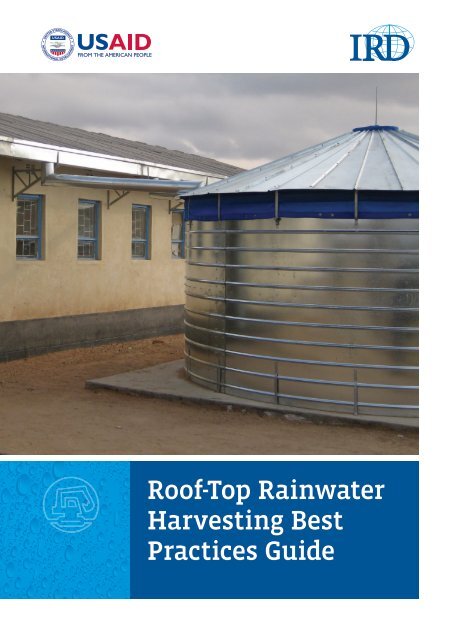
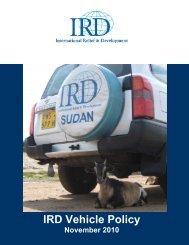
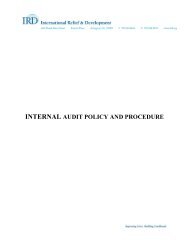
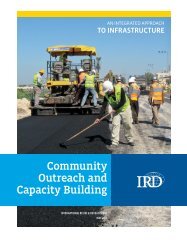
![Guide bonne pratique production d'oignon qualité_VF_4_2411012[1]](https://img.yumpu.com/23506639/1/184x260/guide-bonne-pratique-production-doignon-qualitac-vf-4-24110121.jpg?quality=85)

